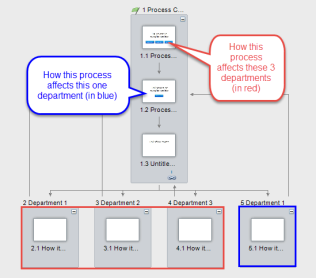Archive
Using Articulate Storyline branching to break down corporate silos.
I have a 17-year old teenage daughter. She is currently making sure that our family is aware of her new found sense of “independence” 🙂
In fact, as we get older, in some ways we become independent, but more so we need to become INTER-DEPENDANT. As adults, we need to fit into more and more social groups. We have to work within those groups, and only then will the group give us respect and a real sense of “belonging”. Just at the time we think we are breaking the bonds, in fact we need to make some of those bonds stronger.
It’s very similar to corporate life. So many departments get entrenched in silos, and forget how they affect other groups, and how other groups rely on them.
Articulate Storyline makes branching easy, so how about this…
If you are creating a process course, or even compliance, create buttons that trigger loops/breakout sections where you explain how changes and requirements affect, or are linked to the OTHER departments in a company. Thee might be departments that the learner seldom, if EVER comes into contact with, but it can place their life in a bigger framework.
Try and get the content from the perspective of the SMEs in the other departments.
As Instructional Designers, we are always “make content real”, and “make it matter” to the learner, and this can help bring the smaller tactical picture into the larger strategic one.
Why not suggest it to your clients?
You might just find that it benefits them too, and they see your added strategic value – always a good way to get repeat business.
What does “engaging” mean?
Those lovely people at Sparkol asked a few people, (including me…), to explain what we meant by the word “engaging”.
We all seem to mean the same thing (a good thing I suppose!), but some interesting perspectives from different parts of the “scribing” community.
Some more suggestions for a more successful freelance ID business life…
Hi again!
Once again a few more thoughts from your friendly Articulate freelance Instructional Designer on how to make your business a little more successful.
Before you ask – yes…they are all from personal/(bitter?) experience.
Getting Instructional Design Closer to the Business
I am constantly amazed by instructional designers that think that “training” is what they do, rather than “help businesses”, and ignore some of the norms of business behaviour and thinking.
So – here’s 5 things you can do to get closer to business.
Articulate Challenge – Audio Setup and Tips
Quick post – my entry for this weeks Articulate Elearning Challenge – audio tips and tricks.
A really GREAT thread appearing on the Challenges page, superb hints and tips for anyone wanting to try voiceover on an eLearning course.
Learning Technique – from the window of a high street butcher, (warning, contains pork).
I was walking to a client earlier this week, and I passed an old-fashioned high street butchers shop. On the window was an advert which read “Pork…it’s tasty…try some now!”
I laughed to myself, thinking about the simplicity and almost child-like communication. How “quaint”. 7 hours later, after a heavy day of Articulate Storyline examples and semantic juggling, I walked back to the station, once again passing the same advert.
It was a GREAT example of learning technique
- State the case for something to your learners – “Pork…”
- Explain the potential benefits to the user – “…it’s tasty”
- State the solution to an assumed problem (lack of pork), with a specific behavioural action – “…try some now”
I had just spent a day largely doing just this – taking words and messages, and simplifying them with/for a client into learner actions. Perhaps we should all, occasionally, look back to the past to see where we are going.
In the interests of keeping the “pork” theme going – I remembered a simple flowchart I once produced using Articulate Storyline – so I’ll leave you with the “Should I Eat Bacon” flowchart“.
Forget the eLearning authoring tool, remember the audience
Last week I was invited by a Marketing department to review their proposed eLearning. They were concerned at the constant re-education needed for sales people – “…they just don’t remember what we teach them”.
Their use of Articulate Storyline was excellent, branching, layers, states, and so on – so why wasn’t the training being successful?
Over the first couple of hours, they mentioned, several times, that “…what we do is very complex”, and their aim was to try and get salespeople to “expert” level. In this case, this was a valid requirement, salespeople do need expert-level knowledge to perform a consulting role for clients.
Using a flipchart, I showed them that what they DO is actually very simple, using about 3 squares, 3 symbols, and two arrows. What was complex was HOW they did that – they had never put all the complex facts into a simple overall framework. Their teaching had no framework, and I suspect that this is why sales never remembered anything.
Their role, as Marketing was to be “sales support”, and I think they had just become the “sales confusion department”.
I received an email the next day, and I quote “… I can see now the importance of thinking from the end-user perspective and also to try to keep the content to a minimum and use illustrations, videos etc. to keep things interesting rather than bombarding the viewer with words.” That is partly true, as it also needs to be relevant and meet sales’ ends, but they made a huge leap forward.
When faced by the “classic SME” situation, be prepared to challenge, and talk in business-related language. Get out of your comfort zone. They wanted to know how to use Articulate Storyline more effectively. I explained how to run their business more effectively, using Storyline as one of the tools to get there, and they will now create courses, (and job aids…) so much for effectively because of that.
The perfect formula for eLearning
Here’s a link to a Guest Blog I made earlier today, some thoughts on “perfect” eLearning.
If such a thing exists.
The science of Umami, and why Instructional Designers should care.
I cooked a steak for supper yesterday, and finished off the mushroom, onions and red wine sauce with some umami powder.
Some what?
Umami – the taste of “savoury meatiness”, found in parmesan cheese, lemon peel, mushrooms, and synthesized as monosodium glutamate, or “flavour enhancer”.
Scientifically identified in 1908, yet we still mainly teach that there are 4 tastes – sweet, salty, sour and bitter. Why over 100 years later is the term still in its infancy?
What’s this got to do with Instructional Design?
Well…
We still talk about “learning styles” – perhaps they should just be viewed as preferences?
Many people still let SMEs give us bullet points, but how often do we explain what bullet points ACTUALLY ARE? (…how many of us know?)
We still mainly “tell” in courses, rather than let people discover their errors, and then learn how to solve problems. We are scared of people feeling as though they “failed”, (even if they DID, but we then explain WHY and let them practice for success, in a safe, online environment).
How long will it be before we have the courage, as a profession, to constantly and assertively let our Subject Matter Experts and customers know that there IS another way, that there is an alternative to linear courses?
Changing perceptions and comfort zones is a hard road to follow, but it IS our job to do it. Challenging can be scary, especially when the next invoice is riding on it, but ultimately, it is HUGELY rewarding, both for us, and our clients.
